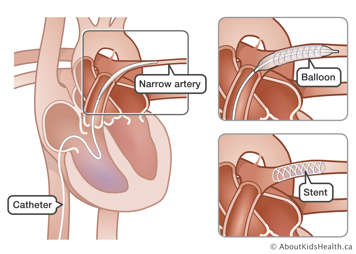A stent is a small metal tube made of metal alloy. When part of a major blood vessel or conduit becomes narrowed (stenotic), the stent helps to widen the narrowed passage by supporting the walls of the blood vessel or conduit to keep it open.
How is a stent inserted?
The stent is inserted in a special cardiac procedure room. The procedure is performed while your child is under a general anaesthetic. This means that your child will be asleep during the procedure.
Once your child is asleep, a thin plastic tube called a catheter is inserted into the blood vessel in the groin at the top of one leg or both legs. Pictures are taken of the narrowed vessel using a type of X-ray called fluoroscopy. The doctor threads a special catheter with a balloon and stent through your child's blood vessel to the narrowed area. The balloon is inflated. This forces the narrowed area open and expands the stent. The stent stays in place permanently to keep the vessel open.
The catheter is then removed and the entry site at the top of the leg is covered with a bandage.

What are the potential complications?
The stent may be misplaced and a second stent needed, although this rarely occurs. If a stent is in an unsafe position, it will be removed, usually during catheterization. Surgery may be necessary in a few cases.
The opening may need to be enlarged later, usually because it could not be fully widened during the initial procedure. Less often, tissue grows into the interior of the stent, causing it to become narrowed again.
Your child will be given medicine to thin the blood so that blood clots will not form in the stent. Rarely, a clot may form anyway. If this happens, the clot can be dissolved with medicine.
